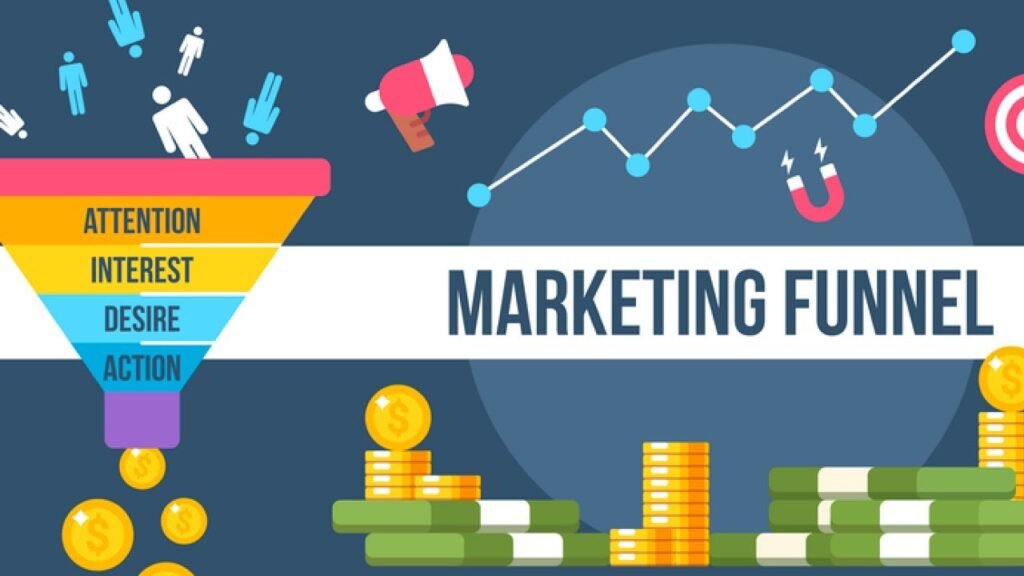Let’s cut through the buzzwords and shiny strategies. Funnel marketing has become a staple term in digital marketing, but not everything you hear about it is true—or useful. Let’s dive into the real stuff: what works, what doesn’t, and how you can build a funnel that actually converts.
What Is Funnel Marketing, Really?
At its core, funnel marketing is the process of guiding potential customers through stages—from awareness to decision—to eventually make a purchase or complete a desired action. This isn’t just a business theory—it’s a reflection of how people think, browse, and buy.
Think of it like planning a road trip. You don’t just jump in the car and drive—you map your route, make pit stops, and avoid dead ends. A good funnel does the same.
Breaking Down the Funnel: The Four Key Stages
-
Awareness:
This is where people first discover your brand, often through content like blog posts, social media, or ads. -
Interest:
They’re intrigued but need more info—maybe a free guide, email series, or webinar to explore your offer. -
Decision:
Here, they’re comparing you with others, evaluating reviews, features, and value. -
Action:
The conversion moment. They buy, subscribe, or fill out your form.
Most marketers stop here—but we’ll talk about what happens after this later.
The Funnel Isn’t Always Linear
Here’s a truth bomb: real customer journeys don’t look like neat little cones. People hop around, revisit steps, and get distracted. Your job? Design a funnel that meets them where they are—on any step, at any time.
Many digital funnels fail because they assume everyone moves step-by-step. That’s just not how human behavior works.
What Actually Works in Funnel Marketing
Let’s drop the theory for a minute and talk tactics. Here’s what really moves the needle.
1. Start With the End in Mind
Before building anything, get clear on the goal. Is it sales, email signups, webinar attendees? Knowing your conversion goal shapes every part of your funnel—from your content to your call-to-action.
2. Use Value-Based Lead Magnets
Not all freebies are equal. Offering something genuinely helpful (like a toolkit, template, or strategy guide) builds trust and gets better leads than a generic “subscribe to our newsletter” pitch.
3. Email Still Rules
Email marketing might seem old school, but it’s still one of the most effective tools to move leads through your funnel. Personalized, segmented, and behavior-triggered emails work wonders.
4. Nurture with Storytelling, Not Selling
People love stories, not sales pitches. Use your emails, landing pages, and ads to tell customer success stories, share insights, and make the journey feel personal.
5. Retarget Like a Pro
Use retargeting ads to reach people who bounced at different stages. Don’t just pitch—re-engage with tailored messages based on where they left off.
Common Funnel Marketing Myths (Debunked!)
Let’s clear up some myths that lead businesses down the wrong path.
-
Myth: You need a complex, multi-step funnel to be successful.
Truth: Simplicity wins. A clear offer and straightforward path beat over-engineering. -
Myth: Every lead should be nurtured the same way.
Truth: Different people, different journeys. Use segmentation to personalize. -
Myth: Funnels are only for online businesses.
Truth: Any business with customers can use a funnel, even brick-and-mortar shops. -
Myth: If your funnel doesn’t work, you need more traffic.
Truth: Sometimes it’s not about traffic—it’s about messaging and conversion design.
How to Diagnose a Broken Funnel
If your funnel isn’t converting, don’t panic. Here’s how to troubleshoot it:
-
Check the bounce rate: Are people leaving your landing page too fast?
-
Review email engagement: Low open/click rates mean poor subject lines or irrelevant content.
-
Inspect conversion points: Are your calls-to-action strong and clear?
-
Test your offer: Maybe it’s not compelling enough—or needs a new angle.
Sometimes, it’s not the funnel—it’s the traffic source, or even the audience targeting.
Customer Journey ≠ Funnel Stages
Here’s where many brands get it wrong: assuming the funnel is the customer journey. It’s not. A funnel is a tool. The journey is emotional. Real people want to feel understood, supported, and valued. Build experiences—not just pipelines.
Use Tools, But Don’t Rely on Them
Yes, there are endless tools out there to automate your funnel—email platforms, CRM systems, landing page builders, and so on. But the tool isn’t the strategy. A bad funnel with great software is still a bad funnel.
Focus first on the psychology of your buyer—then bring in the tech.
Keep It Human: The Secret Ingredient
Want to know the real secret to funnel success? Being human. Personalize messages. Acknowledge doubts. Use humor. Don’t sound like a robot trying to sell something.
Even Red Shoes Inc. once revamped their boring funnel by tossing the jargon and just being real with their audience—and boom, conversions soared.
Frequently Asked Questions (FAQs)
1. Do I need a funnel for every product or service?
Not necessarily. Start with one core funnel that works, then branch out if needed.
2. How long does it take to build a working funnel?
It varies, but a solid funnel can take a few weeks to research, design, and test.
3. Can I run ads without a funnel?
Sure, but you’ll waste money. Ads work better when they lead into a well-designed funnel.
4. What’s the best software for funnel marketing?
Popular options include ClickFunnels, Leadpages, and ConvertKit—but pick one that fits your workflow.
5. How do I know my funnel is working?
Track KPIs like conversion rate, lead quality, and customer retention. If those are strong, your funnel is doing its job.
6. What’s the biggest mistake in funnel marketing?
Ignoring your audience’s needs. Funnels that talk at people instead of to them rarely convert.
Final Thoughts: It’s About Connection, Not Clicks
Funnel marketing works—but only when it’s built on connection, clarity, and consistency. Forget the fluff, skip the over-complication, and build something that reflects how people really decide.
Stay real. Test smart. Optimize constantly.













































